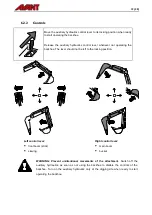
17 (28)
6.1
Checks before use
Check that all obstacles, including any possibly hidden ones, have been removed from the working
area before operation.
Make sure that it safe to dig at the location. Find out if there are electric cables, water lines or similar
at a depth that can be reached with the equipment. Find out about local regulations concerning
digging safety. It may be mandatory to contact local authorities before starting digging operations.
Check the bucket is positively locked and the bucket pins are secured.
Operate the digger only at well lit areas.
Ensure that bystanders are at a safe distance when operating the equipment. Do not let anyone to
enter danger area of the boom or to stay directly in front of the loader. Also make sure that it is safe to
reverse with the loader. Never assume that bystanders will remain where you last saw them;
especially children are often attracted to the moving equipment.
Check the general condition of the attachment and the loader, and check for possible hydraulic oil
leaks. The attachment must not be used, if there is a fault in the hydraulic system of the loader or the
attachment. Refer to Chapter 7 for maintenance instructions.
Operate the attachment and the controls of the loader only when seated on the driver’s seat. Ensure
that the loader and the attachment are used in a safe manner and as intended. Do not allow children
to operate the equipment.
Never operate the loader or attachments while under the influence of alcohol, drugs, medication that
may impair judgement or cause drowsiness, or if not otherwise medically fit to operate the equipment.
Remember correct working methods and avoid leaving the driver’s seat unnecessarily.
.
..
6.2
Operating the backhoe
Check the attachment and the operating environment once more before starting to work, and that all obstacles
have been removed from the operating area. Quick inspection of the equipment and the operating area before
use are parts of ensuring safety and the best performance of the equipment.
The backhoe is controlled with its two control levers.
After the backhoe is connected correctly to the loader, lower it on the ground using the loader boom.
For the best stability, enough weight must be applied on the frame of the backhoe and the outriggers.
The front of the loader can be lifted slightly off the ground.
Adjust the loader engine to run at medium rpm. Check the operator's manual of the for RPM setting
that provides auxiliary hydraulic flow within recommended range.
Make sure the backhoe is locked correctly on the loader.
Never use the backhoe
without the supporting bracket correctly fitted.
The purpose of the bracket is to lock
the tilting, reduce stresses on loader boom, and to make the backhoe more stable for
more effective operation.
































